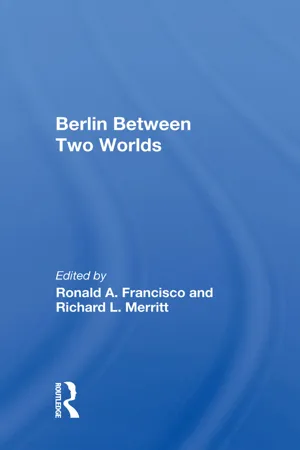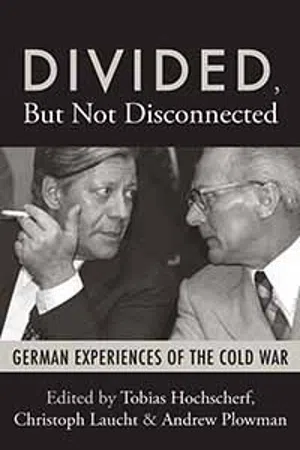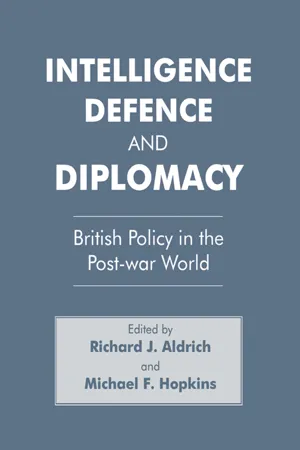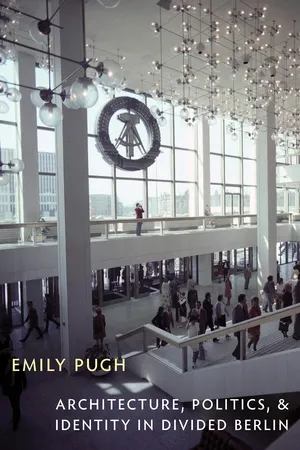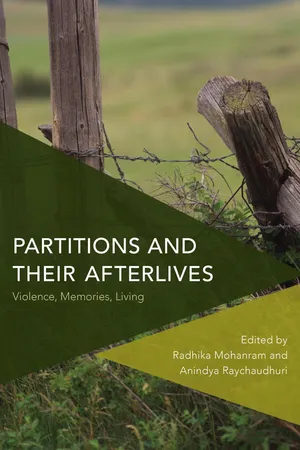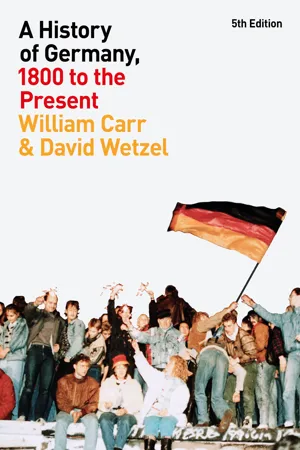History
Division of Germany
The division of Germany refers to the separation of the country into East Germany (German Democratic Republic) and West Germany (Federal Republic of Germany) following World War II. This division was a result of the Allies' decision to split Germany into four occupation zones, with the eastern portion falling under Soviet control and the western portion under the control of the United States, Great Britain, and France.
Written by Perlego with AI-assistance
Related key terms
1 of 5
12 Key excerpts on "Division of Germany"
- eBook - ePub
- M. Donald Hancock, Henry Krisch(Authors)
- 2008(Publication Date)
- CQ Press(Publisher)
3Germany Divided and Unified
G erman politics during the twentieth century was dominated to an unusual extent by history and Germans’ reactions to that history. The half century of Germany’s foreign occupation, division, and unification forms the immediate chronological background to the contemporary scene. For more than forty years, German politics were shaped by powerful external forces of foreign occupation and alliances and by an intense inter-German competition between the two German states created in the war’s aftermath. The end of the Cold War signaled an end to this postwar phase of German history. In the following chapters, we explore the problems and prospects of German politics, domestic and foreign, now and in the near future. Here, we first review the course of German division and the country’s unification.During the Cold War era of German history (1945–1990), three themes dominated politics in both East and West Germany: the future of the German national state, German national identity in its historical context, and the impact on German politics of the international environment. German politics also was animated by contentious domestic social and economic issues. Indeed, the two German states developed starkly contrasting socioeconomic systems. From the perspective of the unified Germany of the twenty-first century, however, with its dominant West German political and economic systems, that economic and social competition is important for the part it played in forming German identity.The Germans dealt with these issues in the framework of two rival states, each linked to a major Cold War bloc. This “cold civil war” on German territory ended with the collapse of the East German state in 1989, the acquiescence of the Soviet Union to German unification within the Western alliance a year later, and the unification of Germany as the Federal Republic of Germany. This proved to be a struggle between two uneven partners. The victorious western Federal Republic was larger, more populous, better endowed with natural resources, and linked to the economically and militarily more powerful ally. Thus the resolution of Germany’s problems in the Cold War historical era has led to a united Germany that must cope with a difficult dual heritage (Nazi and communist), as well as with the task of integrating a poorer, smaller, defeated region into the modern German polity.1 - eBook - ePub
- Ronald A. Francisco(Author)
- 2019(Publication Date)
- Routledge(Publisher)
1 Introduction: Divided Berlin in Postwar PoliticsRonald Α. FranciscoBerlin has been a central issue in the postwar dispute between East and West. Often it has been the site of political tensions that brought the Soviet bloc and the West to the brink of open combat. Its geographic location, unique political status, and dramatic division have made Berlin an important symbol in the struggle for the control of Germany and central Europe. Berlin's present role in international politics is noticeably muted. Yet its political status remains essentially unchanged. It remains sharply divided between East and West even after the past decade's concessions from both sides. Its geographic locations is now no less important strategically or politically.The Berlin of the 1980s owes its relative quiescence to the diplomacy of the 1970s. By the late 1960s most of the relevant national actors had sufficient incentive to work to defuse the tension that had grown out of the conflicts and raw politics of the previous two decades. Yet because Berlin's political status remains unsettled, its potential to precipitate a crisis and even a military conflict has lessened only by degree. Berlin's future lies in the hands of a diverse set of actors that operates on three basic levels: East versus West; East Germany versus West Germany; and to a lesser extent East Berlin versus West Berlin. The combinations and permutations that occur within and between these levels have become increasingly complex, and are reflected in the multiplicity of international perspectives represented in this volume.This introduction explores Berlin's international position by reviewing the major events of the postwar era in the context of the foreign policy perspective of the major actors. As the subsequent chapters show, the motives and goals of these actors have varied widely and often conflicted directly throughout the postwar period. In fact, much of the intensity of the Berlin problem can be traced to the fact that its postwar structure was jointly designed by allies who failed to anticipate the fundamental political struggle that was to grip Europe in the wake of World War II. - eBook - PDF
A History of Germany 1918 - 2014
The Divided Nation
- Mary Fulbrook(Author)
- 2014(Publication Date)
- Wiley-Blackwell(Publisher)
West Germans and the Western allies effectively jettisoned the Germans living in the Soviet zone in the East, in favour of integrating a partial state into a new order in Western Europe. Debates continue over interpretations of the Cold War more generally – was it the Soviet Union or the USA which was the primary aggressor? Did the Americans misjudge and exaggerate Soviet expansionism, or did they simply act appropriately to contain a real Soviet threat? These wider debates obviously have relevance to attempts to understand the Division of Germany, but further factors are also of importance here. For example, whatever the Occupation and Division, 1945–1949 137 origins of the Cold War, it is conceivable that Germany could have remained united, as a neutral power (as was in the end the case with Austria), with the Iron Curtain running along a different frontier. Moreover, in asking who was responsible for the Division of Germany, one must focus not only on the superpowers, but also on the role played by the Germans themselves. While the chronological stages of division may relatively easily be recounted – with the West appearing to take the initiative at almost every turn – the balance of interpretation must remain somewhat more tentative. Elements of a postwar division into ‘spheres of influence’ had already been mooted in informal ‘friendly agreements’ between Churchill and Stalin in 1944. But while recognizing the legitimacy of spheres of influence in an informal way, no decisions had been reached on Germany in particu- lar before the end of the war. An important factor after the cessation of hostilities was the zonal, rather than central, level of effective administra- tion, as we have seen above. This inevitably led to the de facto divergence of socioeconomic and political conditions in each zone. But a major factor was the increasing concern of the Americans with a perceived Soviet threat. - eBook - ePub
- Matthew Stibbe(Author)
- 2023(Publication Date)
- Manchester University Press(Publisher)
Part II Divided Europe and the politics of history: ‘1918’ in the two GermanysPassage contains an image
3 Revolution betrayed or democracy saved? West German debates, 1949–79The Cold War, which developed apace after 1949, was a truly worldwide phenomenon. Its global reach was underlined by events such as the Korean War of 1950–53, the testing of the first H-bomb in 1952, the Sino-Soviet split from 1960 and the Cuban Missile Crisis of 1962. Nonetheless, it also came to have a special ideological and symbolic significance in central Europe, where two German states – the Federal Republic founded in May 1949 and its Communist rival, the German Democratic Republic, established in October of the same year – stood on what for much of the 1950s and the early 1960s seemed to be the brink of all-out war. From 1955 they were also integrated into rival military alliances – the American-led NATO in the case of the FRG and the Warsaw Pact in the case of the GDR.Just as the German nation was split in half after 1949, so too was the German history profession. However, the timeline for this did not follow the course of the Cold War exactly. In the early 1950s there were still some on both sides who hoped that there was enough common understanding to allow for the maintenance of a single professional body for German historians. The final split came in the mid-to-late 1950s. West Germans such as the conservative Gerhard Ritter, President of the Verband der Historiker Deutschlands (German Historians’ Association (VHD)), refused to accept the new East German journal the Zeitschrift für Geschichtswissenschaft, founded in 1953, as a ‘scientific’ publication, denouncing it as Marxist propaganda. Very few western historians would write for it. Then, at its annual conference in Trier in September 1958, the VHD forbade three East German historians – Ernst Engelberg, Max Steinmetz and Leo Stern – to speak if they appeared as official representatives of the Deutsche Historiker Gesellschaft (German Historians’ Society (DHG)), the new East German body that had been founded a few months before. The DHG ordered a full-scale walk-out, and henceforth instructed all of its members to resign from the VHD.1 Finally, in the run-up to the eleventh International Congress of Historical Sciences in Stockholm in August 1960, Ritter successfully pressed the Swedish organisers not to allow an official delegation from the GDR to attend, insisting that there was only one legitimate body for German historians – the VHD.2 - eBook - PDF
Divided, But Not Disconnected
German Experiences of the Cold War
- Tobias Hochscherf, Christoph Laucht, Andrew Plowman, Tobias Hochscherf, Christoph Laucht, Andrew Plowman(Authors)
- 2010(Publication Date)
- Berghahn Books(Publisher)
Towards the East, the new Oder-Neiße borderline fixed basic outcomes of the Second World War, in particular the loss of the Eastern territories and the ensuing expulsion of their remaining Ger- Divided, but Not Disconnected ■ 15 man population. Within the remaining German territory the internal state border served to stabilize the East German dictatorship and – espe-cially after the construction of the Berlin Wall in 1961 – the international balance of atomic powers. For the Western world, West Germany’s bor-ders became a site of its gradual economic and cultural integration into Western Europe and the transatlantic alliance. Following the unconditional surrender, the German state’s territory was divided, the resulting parts separated by borders defining the four oc-cupation zones and the four sectors of Berlin, and thereby the respective jurisdiction of the four military administrations. Zonengrenzen (zonal borders) equipped with checkpoints and passport controls surveyed and managed the movement of people and goods between these territories – a basic technique to (re-)institute centralized authority. 7 With the Cold War unfolding and the East-West schism producing two distinct projects of state-building in Germany, the inner German border became a key site in the further implementation of such new executive powers. The borderline between the territories occupied by the Western allies and the Soviet Union became the Zonengrenze (zonal border) in the singular in western, or Staatsgrenze West (state border west) in eastern terminol-ogy. It was rendered more or less impermeable by the East from 1952. Only the sector border in Berlin remained a highly visible opening in the attempt to close the GDR off from West Germany. This was sealed by the Berlin Wall in 1961, which made Republikflucht (flight from the Republic) across the Western borders extremely dangerous for the rest of the GDR’s existence. - eBook - ePub
A History of Germany 1918 - 2020
The Divided Nation
- Mary Fulbrook(Author)
- 2021(Publication Date)
- Wiley-Blackwell(Publisher)
Debates continue over interpretations of the Cold War more generally – was it the Soviet Union or the United States which was the primary aggressor? Did the Americans misjudge and exaggerate Soviet expansionism, or did they simply act appropriately to contain a real Soviet threat? These wider debates obviously have relevance to attempts to understand the Division of Germany, but further factors are also of importance here. For example, whatever the origins of the Cold War, it is conceivable that Germany could have remained united, as a neutral power (as was in the end the case with Austria), with the Iron Curtain running along a different frontier. Moreover, in asking who was responsible for the Division of Germany, one must focus not only on the superpowers but also on the role played by the Germans themselves. While the chronological stages of division may relatively easily be recounted – with the West appearing to take the initiative at almost every turn – the balance of interpretation must remain somewhat more tentative.Elements of a postwar division into ‘spheres of influence’ had already been mooted in informal ‘friendly agreements’ between Churchill and Stalin in 1944. But while recognizing the legitimacy of spheres of influence in an informal way, no decisions had been reached on Germany in particular before the end of the war. An important factor after the cessation of hostilities was the zonal, rather than central, level of effective administration, as we have seen above. This inevitably led to the de facto divergence of socioeconomic and political conditions in each zone, but a major factor was the increasing concern of the Americans with a perceived Soviet threat.It was the British who first seriously considered not the dismemberment of Germany into a number of small states (as had been mooted in some wartime plans) but rather division with a Western partial state corresponding to the Western zones of occupation. In April 1946, amidst growing fears about Soviet intentions, the British Foreign Office decided that the West German Länder would have to be strengthened and made able to resist any communist-dominated central government and that if it were to come to a Division of Germany, the Soviet Union would have to be made to look responsible.24 - eBook - ePub
Intelligence, Defence and Diplomacy
British Policy in the Post-War World
- Richard J. Aldrich, Michael F. Hopkins(Authors)
- 2013(Publication Date)
- Routledge(Publisher)
3 Reunification or Integration with the West? Britain and the Federal Republic of Germany in the early 1950s Klaus LarresDOI: 10.4324/9781315035925-3The period between the fall of the Berlin Wall in November 1989 and the merging of East and West Germany on 3 October 1990 was marked by worries and the concern of many people that a unification of the two Germanies would destabilize Europe.1 It was alleged that a united Germany with a population of almost 80 million would soon become a new economic superpower and once again an arrogant political giant on the international scene.2 Only very few people believed that the four victorious powers of the Second World War were genuine and unequivocal supporters of the creation of a unified German state. However, developments in Eastern Europe in 1989–90 seemed to make German unification inevitable. Britain, France, the United States and the Soviet Union now had to stand by their many promises to the German people during the previous 45 years and convert these pledges into reality.In the 1950s, when the international scene was still very fluid and the modus vivendi of the Cold War not yet fully accepted, politicians in East and West also kept professing that they were seriously interested in overcoming the partition of Germany as soon as possible.3 Why, then, did it never materialize? After all, politicians and the military in the early 1950s genuinely believed that a permanent Division of Germany would soon lead to turmoil and war. Based on the convictions as expressed at the Potsdam Conference in 1945, they thought that only a united Germany would guarantee a peaceful and economically healthy Europe. Otherwise it was assumed the German people would soon create so much trouble in order to obtain unity and prosperity that the stability of Europe and the world would be seriously endangered.4 This attitude began to change with the gradual Western realization that not only Chancellor Adenauer but above all the West German people, the huge majority of the German population, were not really very much interested in getting the country reunified. Despite the popularity of the unification issue in opinion polls and ‘the simmering discontent with the Division of Germany’,5 the West Germans were apparently much more concerned with rebuilding their own careers and enjoying the fruits of the burgeoning economic miracle than with the fate of their brethren in the East. The High Commissioner in Bonn even claimed that the Germans were mainly interested in the ‘three Bs’ – belly, BMW and building society account.6 - Emily Pugh(Author)
- 2014(Publication Date)
- University of Pittsburgh Press(Publisher)
1 INTRODUCTION On August 13 , 1961 , in the middle of the night, the East German govern-ment closed the border between East and West Berlin, halting people, cars, and trams in their tracks and sealing off the western sectors of the city with barbed wire. The acrimony between the eastern and western Cold War powers had been growing since the end of World War II, yet the intra-city border closure had not been foreseen by citizens on either side of the barricade, and it caught western governments in particular by surprise. 1 The rulers of East Germany declared that, with the border secured against the “fascist” west, peace had finally been established in their country. In West Berlin, the Tagesspiegel newspaper declared the event to be East Ger-man leader “Ulbricht’s demonstration of naked violence” and a “day Ber-liners would never forget.” 2 Twenty-eight years later, another unforgettable day would transpire. On November 9 , 1989 , an unplanned and unexpected announcement regarding changes to the travel restrictions imposed on East Germans rendered the border closure irrelevant. The Berlin Wall “fell,” seemingly as suddenly and abruptly as it was erected. Although Germany’s division into East and West and its subsequent reunification is often conceived of in absolute terms, the divisions did not end with the “fall” of the Berlin Wall on November 9 , 1989 , just as they did not simply appear with the barbed wire on the night of August 13 , 1961 , or even in 1949 , when the GDR (German Democratic Republic; East Ger-many) and Federal Republic of Germany (West Germany) were formally established. In light of the irrelevance of absolutes in terms of division and reunification, the more important issue is how, after Germany had been divided politically and physically, corresponding cultural and social divi-sions were established between 1961 and 1989 .- eBook - PDF
Partitions and Their Afterlives
Violence, Memories, Living
- Radhika Mohanram, Anindya Raychaudhuri, Radhika Mohanram, Anindya Raychaudhuri(Authors)
- 2019(Publication Date)
- Rowman & Littlefield Publishers(Publisher)
109 In Germany, a country where the borders marking two separate states have been consigned to history, life under partition is remembered by those directly affected by it through family stories and more widely in the mu-seums, tourist venues, media and publications that continue to depict it for subsequent generations. The German Democratic Republic (GDR) past is a recurrent subject of public history and media, regularly profiled on the annual anniversaries of the fall of the Berlin Wall and of reunification. It is also a focus for tourism—particularly in Berlin—and of a nostalgia industry. This chapter looks at the afterlives of political partition and reunification as they shape how the GDR is represented in public history and in individual and col-lective memory. It draws on examples from museums, documentary media, oral history and written life stories with particular reference to how they are narrated and mobilized, ideologically and affectively. The chapter looks at what is emphasized and what is excluded as part of a broader concern with the politics of individual and collective memory and considers the wider ideological implications of hegemonic modes of representation. It further seeks to identify issues of relevance to broader understandings of the social and affective legacies of partitions. 1 POSTPARTITION REPRESENTATIONS OF THE GDR The fall of the Berlin Wall is widely regarded as marking the end of the Cold War. Well-known images of this event, widely available in museums, books and tourist publications, in the media and online, show huge crowds of jubi-lant people from East and West celebrating on and around the wall and seem-ingly endless lines of East Germans on foot and in their Trabants, Wartburgs Chapter 5 Legacies of Partition Remembering the German Democratic Republic Chris Weedon 110 Chris Weedon and Skodas, queuing to cross from East to West. - No longer available |Learn more
A History Shared and Divided
East and West Germany since the 1970s
- Frank Bösch(Author)
- 2018(Publication Date)
- Berghahn Books(Publisher)
Third, as a result of the intense rivalry between East and West Germany and the mutual insistence on drawing lines of demarcation, the two states were more closely tied to one another than to other neighboring countries. On the one hand, they were permanently engaged in refuting practices and concepts coming from the other side of the Wall; on the other hand, this rivalry spurred on domestic improvements in each state, be it in terms of social policy or education, sports, or dealing with the Nazi past.Last, given the shared history of Germany since reunification in 1990, it also makes sense to look at the decades beforehand from a shared perspective, not with a focus on 1989, but rather with an eye to the difficulties involved in growing together as one Germany. Such an approach allows for a better understanding of why there are still significant differences between East and West even today. Both Germanys are the divided past of our unified German present.It must be kept in mind, however, that many things were different in East and West, even if they shared the same name. A political party or trade union in the West was fundamentally different from a political party or trade union in the East. Likewise, the search for transfers and entanglements bears the risk of overinterpreting the relevance of individual contacts, interactions, or mutual observations—a danger that is inherent to transnational history in general. Moreover, the creation of a new teleological master narrative leading up to 1989 has to be avoided.62 Not only do historians need to explain the downfall of the GDR, but also they have to account for its long-lasting stability, which made even West German experts think that reunification was not on the horizon in early 1989. And, finally, it cannot be assumed too rashly that a sense of national unity or a shared German identity in both states justifies a joint perspective in and of itself. Even within the GDR, a feeling of “we” evolved that did not necessarily correspond to the “socialist nation.”63 Too little attention has been paid up to now on how the concept of the “nation” developed within the context of divided Germany and how stronger supranational identities were built before and after unification.64 - eBook - PDF
A Constructed Peace
The Making of the European Settlement, 1945-1963
- Marc Trachtenberg(Author)
- 2020(Publication Date)
- Princeton University Press(Publisher)
There was no longer any chance that the two sides would accept a settlement based on the simple idea that the Soviets could do what they wanted in the east, while America and her friends would have a free hand in T O W A R D T H E R U B I C O N ' 55 the western zones. The clash over Germany was thus to be the mainspring of in-ternational conflict during the Cold War period. THE END OF THE LINE By the end of 1946, the course of western policy seemed set. In the immediate postwar period, Britain and America had been reluctant to move too quickly or too overtly toward the organization of the western zones—toward allowing them to recover economically and indeed politically as well. They had held back for a variety of reasons: a general desire to avoid a split with the Soviets; a sense that a breakdown of the alliance might well lead to a resurgence of German power, with the Germans playing off east against west; a certain fear that a divided Germany would never be acceptable to the Germans, whose efforts to recover their national unity would be a source of profound instability in Europe; and, above all, a strong wish to avoid blame for the Division of Germany, especially in the eyes of the Ger-mans themselves. But with the passage of time, many of these concerns were losing their force. The split with the Soviets was coming to be taken as a basic fact of international political life. The Division of Germany was coming to be seen as a natural, perhaps even as an inevitable, consequence of the collapse of the wartime alliance. And the more unavoidable it came to seem, the less the western powers had to worry about being blamed by the Germans for the division of their country if they took action to restore their economy and set up some kind of political system in the western zones. With the passage of time, moreover, the arguments for action became more compelling. The Germans could not be kept in a state of limbo forever. - eBook - ePub
- William Carr, David Wetzel(Authors)
- 2023(Publication Date)
- Bloomsbury Academic(Publisher)
15 A Nation Divided1945: A Shattered CountryIn the summer of 1945 Germany was utterly devastated. Great cities had been reduced to heaps of smoking rubble, communications were totally disrupted, and the administrative apparatus shattered. The German people were dazed and bewildered by the ordeal of total war. Over three million German soldiers had been killed in action, one million were prisoners of war in Russia, many never to return, and half a million civilians had been killed in air raids. Heim ins Reich , the proud Nazi slogan of the 1930s, took on a new meaning as millions of panic-stricken refugees streamed westward before the advancing Red Army.Before the fighting ended, the “Big Three”—Roosevelt, Stalin, and Churchill, meeting at Yalta in February 1945—set the seal of approval on arrangements for the occupation of Germany, which were dictated in large measure by the nutcracker strategy they had pursued. Temporarily Germany would be divided into four occupation zones: the Russians in the east, the British in the northwest, the Americans in the southwest, and the French in a small zone in the west carved out of the British and American zones. Authority would be vested in an Allied Control Council consisting of the four commanders in chief meeting in Berlin. That city, to be occupied by the four powers, would remain the German capital. Germany would be demilitarized, denazified, and obliged to pay reparations, not in money—the error of the 1920s—but in kind. While no formal figure was agreed on, 50 percent of the reparations would be given to Russia in recognition of the immense devastation caused by German aggression.With their armies firmly in control of Germany, the Big Three met at Potsdam in July 1945. By this time the Americans had abandoned the Morgenthau Plan to pastoralize Germany and divide it into several small states. German unity was preserved although for the time being a central authority would not be reestablished. But political recovery would be encouraged along democratic lines in all zones. A more immediate task was denazification which the occupying powers undertook enthusiastically—indeed, this turned out to be the only subject on which complete agreement could be reached. The most spectacular example of four-power unity was the Nuremberg Trial of major war criminals in 1945–6, when leading Nazis and their advisers were tried and in nearly all cases found guilty of conspiracy to commit wars of aggression and crimes against humanity. The reparations arrangements were shrouded in some ambiguity. Each power was to dismantle industrial plants in its own zone and take goods from current production. At the same time the German economy was to be treated as a whole and the German people permitted a standard of living no higher than that of neighboring peoples. To coordinate economic activity in the zones five central administrative offices staffed by Germans would be set up. Already deeply uneasy about Russian actions, President Harry S. Truman and Clement Attlee, the newly elected British prime minister, promised Russia only 25 percent of reparations deliveries from their zones. Finally—and with great reluctance—they accepted a major territorial change in Germany’s eastern frontiers ahead of a peace treaty: de facto Polish administration of former German territory up to the line of the Oder and Neisse Rivers and the partition of East Prussia between Russia and Poland.
Index pages curate the most relevant extracts from our library of academic textbooks. They’ve been created using an in-house natural language model (NLM), each adding context and meaning to key research topics.

